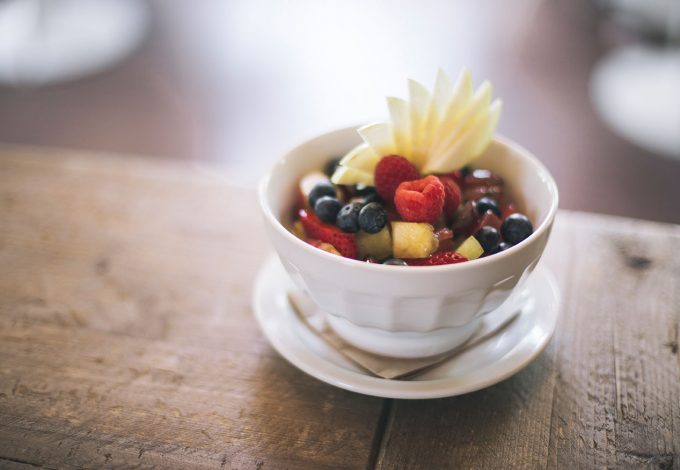Michaël Bensoussan, a gastroenterologist at the Hôpital Charles-Lemoyne in Longueuil, diagnoses and treats digestive tract disorders. Jean-François Lemoine, for his part, is an agronomist who works as a consultant with farmers to help them improve their production. We welcomed them to Strøm Nordic Spa — Mont-Saint-Hilaire, and they shared their knowledge with us with great generosity, allowing us to learn more about the relationship between the industrialization of food and its effects on our health.

Strøm spa nordique
Hello, you two. Michaël, can you tell us a little about intestinal microbiota?
michaël bensoussan
“Microbiota refers to the bacteria with which we live in harmony—in our nasal cavities, in our bronchial tubes, on our skin, but especially in our digestive tract, where a trillion bacteria can be found. If we add up all the cells in the entire human body, in all the organs, we get to a hundred billion, or ten times fewer. In absolute terms, therefore, we are made up of more foreign material than material inherited from our parents. There are 1,200 different bacterial strains that weigh between 1 and 1.5 kilograms in total in our digestive tract. Without them, human beings would be incompatible with life. We are born with a sterile intestine, and this bacterial colonization begins at the time of delivery, while the infant is in contact with the mother’s vaginal flora. Breastfeeding continues this work when the baby puts the mother’s breast, along with the microbiota of the mother’s skin, into their mouth. In maternity wards in Quebec now, when a child is born by Caesarean section, we put a cloth in the mother’s vaginal walls and coat the baby with this vaginal flora, because we know that this is part of the process, from the first seconds of life, of developing the intestinal flora.
“Why is this so important? Because we realized that, behind several digestive, neurological, and probably even cancerous diseases, there is an imbalance in this intestinal flora. When the microbiota is balanced, we are in symbiosis with bacteria. In a situation of imbalance, some bacteria become dominant and fight against others that are beneficial to our health. This is what is known as dysbiosis. This is present in people who have intestinal diseases, obesity, diabetes, and in those who have an overly fatty, caloric, and processed diet. From the perspective of intestinal flora and microbiota, we become what we eat.
“A few years ago, it was said that intestinal flora played a role in digestion. Then, it was understood that it was involved in the development of digestive diseases. And recently, we are realizing that it communicates with the nerves of the intestine. There are 200 million neurons in the intestine, which is why it is called the second brain. It is the organ in the human body where the most neurons can be found after the brain. The bacteria communicate with the 200 million neurons in the intestine, which themselves communicate millions of times per second with our brain. This means, therefore, that the bacteria in our intestine are giving orders to our brain. We have long known that the power of the brain on the intestine is immense; we are now realizing that the reverse is probably also true.”
jean-françois lemoine
“I thought that for Crohn’s disease and ulcerative colitis, there was a genetic dimension.”
michaël bensoussan
“Of course! But in our microbiota as well, there is a genetic portion. That is to say that it is genetically pre- disposed. With all the cells on the surface of our intestine that will more or less adhere to this or that bacterium, each person in the world has a different microbiota. A person can be identified with even greater certainty from their microbiota than from their fingerprints or the irises of their eyes. It is unique to each person: on one hand, it is genetically codified, and on the other, it is influenced by what we eat, among other things.”
Strøm spa nordique
Does this mean that our diet has the power to make us sick?
michaël bensoussan
“What the medical literature tells us is that there are many more diseases in the countries of the northern hemisphere than in less developed countries—for example, in the southern hemisphere. This is even truer in gastroenterology: we are the number one country in the world for ulcerative colitis per person. What we also know is that when populations from other countries and other genetic backgrounds immigrate to Canada, they end up having the same number of diseases as people who were born here. So, there are obviously problems here that are causing diseases.
“If I knew what these problems were, I would be pleased to name them for you. We are finding them as science progresses, but afterwards, we can also reason with our common sense. What is the difference between an industrialized country like ours and less industrialized countries? It’s the pollutants found in the atmosphere, water, and soil, where the food we eat grows. But above all, it’s the industrialization, the ultra-processing of food. It’s necessary to understand that all foods that come from the ground are processed, if only when we are preparing to eat them. Ultra-processing is something else entirely: it’s the industrial process that transforms foods using chemical compounds, which are usually preservatives, flavouring agents, etc. And when we start putting these kinds of compounds in the food we eat, we can no longer really predict what effects this will have on our bodies. I think we can say that people who buy their vegetables at a farmer’s market, their meat from a butcher, their bread from a baker, and their fish from a fishmonger won’t have any health problems related to their diet, since none of these products is ultra-processed.”
jean-françois lemoine
“And even if they do have traces of pesticides from the way they were grown, eating some fruits and vegetables is much more beneficial for your health than not eating any at all!”
michaël bensoussan
“ Definitely. People just have to consult Canada’s Food Guide, which is extraordinarily well done. It recommends animal protein or alternatives, plant- based proteins, dairy products, but maybe a little less than before—in short, a varied diet that is as local as possible. Did you know that, in Canada, we buy frozen green beans that were grown in China?”
jean-françois lemoine
“That blows me away, when we grow such good ones here! But often, their price doesn’t suit the grocer, who prefers to import them. People need to find out where their food comes from and sometimes be willing, in the off season, to pay a little more to buy local. For example, my kids and I are dill pickle fans. However, even though cucumbers grow in Quebec, I can’t find a jar of local pickles in any of the grocery stores I visit. The cucumbers there come from India and may have been sprayed with pesticides that are banned here.”
michaël bensoussan
“While it’s so easy to make them at home! We should give ourselves the time to cook despite the hectic pace of our lives. We would eat much fewer ultra-processed products. It would change everything! Thirty to forty percent of the people who consult a gastroenterologist have so-called functional digestive conditions such as irritable bowel—that is, there is no underlying disease. These types of conditions are at least half-related to our lifestyle, stress, and especially what we eat. We take what we can get on the go, a piece of pizza while walking, a sandwich while answering emails. But when you have a fragile intestine, you have to sit down, eat a meal (preferably a hot one) that was just prepared with good ingredients, put down your phone, and drink a few sips of water to hydrate at the same time. When we recommend that our patients do that, more than half of those who had an irritable bowel or dyspepsia problem—that is, problems with the stomach and oesophagus—see their symptoms disappear like magic. It’s because they have reclaimed the moment of the meal, the act of ingesting food.”

Strøm spa nordique
Does gluten, which has been talked about so much in recent years, have an impact on people’s health?
michaël bensoussan
“In 2022, between 8 and 10% of the Canadian popula- tion is gluten-intolerant and has bloating or digestive disorders. A portion of these people actually have an irritable bowel, and this is what makes it hard for them to digest gluten. Then, there are 1 to 2% of people who suffer from celiac disease, an auto-immune disease triggered in the intestine by ingesting gluten which, in the long term, damages the intestine, causes severe disorders, anemia, and nutritional deficiencies, and which can possibly cause cancer.
“What we are seeing is that there are many more celiac and gluten-intolerant people than before. The only plausible explanation I can see is the industrialization of the wheat cycle. Once it is harvested, we do almost everything with it: from the sliced bread found at the supermarket to which sugar, fat, and salt are added, and which therefore no longer has much to do with bread, to the sourdough bread made by the baker, who usually works directly with smaller producers, chooses their flours, and mixes them to offer a much less processed product. For the consumer, everything is available, and everything is possible. But has the consumer’s relationship with gluten and wheat changed over the past few decades? My observation as a doctor is yes!”
Strøm spa nordique
Jean-François, what is gluten and what is it used for?
jean-françois lemoine
“The entire Poaceae family, including grasses, con- tains gluten. Gluten is made up of two proteins, and regardless of the type of wheat, the gluten is the same. It is there for the seed to germinate and ensure the offspring of the wheat. In the finished product, such as bread, it ensures the elasticity and aeration of the crumb. There are variations from one grain to the next, such as spelt, which contains a lot of it, while other grains contain less, but the gluten remains the same. There are at least 50 types of wheat that grow in Canada: strong wheats for flour, flatbreads, and others for pastries, soft wheat, red spring wheat, etc. But a field remains a field, and is always made up of a single type.”
Strøm spa nordique
How does wheat grow?
jean-françois lemoine
“For fruits and vegetables, there are farmers today who grow on small areas and who can sell directly to individuals, because the resource they produce lends itself well to that. It is consumed directly, without major processing, by the consumer. But for grains and oilseeds such as corn, soy, and wheat, it takes large areas to make them grow. For example, in your garden at home, you can plant a few tomato plants and eat them almost all summer long, but if you had to plant wheat to try to make your own bread, you wouldn’t have enough space! Grain and oilseed cultivation is therefore more industrialized in Quebec than fruit and vegetable cultivation because it requires large spaces and significant equipment and involves considerable processing before reaching the consumer. Efficiency, productivity, and profitability factors also come into play. There are eight billion human beings on Earth. We have to feed this world of ours, and we mustn’t forget it.”
Strøm spa nordique
In conclusion, what food habits can we adopt to promote microbiota health and our health in general?
michaël bensoussan
“Eat a wide variety of foods. When you have a varied and balanced diet, this is reflected by the intestinal flora. We can also feed it by giving it live products to eat—that is, anything fermented: kimchi, kombucha, kefir, sauerkraut, yogurt, miso, etc.
“You shouldn’t be afraid of whole food categories; it’s all a matter of dosage and use. There are no bad foods among those that Mother Nature gives us. There are no superfoods, either—that’s just marketing. There is a variety of foods. Like kale—it’s true that kale is good, but broccoli is good, too, and so is lettuce!”







